In our current economic system, we take resources out of Earth, make the product, use it and then throw it again as waste on the Earth; this is called a linear economy system. But if we are differentiating between the two systems, i.e., Linear vs circular economy system, then in the circular economy system, we don’t produce waste in the first place. In a circular economy, we focus on three principles:
- Eliminate waste and pollution.
- Circulate products and the materials at their highest value.
- Regenerate nature.
A conceptual overview of Linear Economy
A linear economy is a growth model where the growth manifests the growth of production, employment, profits, living standards, cities, and demand for different goods. In a linear economy, the waste resulting from the process of production is discarded in the environment. The concept of linear economy is: take, make, consume and discard. It assumes n number of available materials which can be used easily. In the Linear economy, we take the material we need, make the products to be sold and make profits out of such products and then dispose of everything which we do not need; also, we dispose of/discard the product in the end when we do not want to use the product anymore.
The Ellen MacArthur Foundation (2013) quantifies some of the costs of the linear economy based on empirical data and economic modelling. It cites the Sustainable Europe Research Institute report, claiming that 21 billion tons of material being used in producing the goods do not get used in the production of the final product. It further claims that the volume of material input to the economy is tallied at 65 billion tons. Then out of them, 2.7 billion tons are dumped as waste in the environment[1]. Then, merely 40% of them are used again through recycling, reusing and composting.
The linear economy is successfully generating material wealth in different industrial nations, but in the 21st century, it is showing some weaknesses. Now in linear vs circular economy, the circular economy is accepted more than the linear economy.
A conceptual overview of the Circular Economy
Pearce and Turner introduced the circular economy. The circular economy concept draws on more specific approaches that gravitate around a set of basic principles. The pan-national organizations such as the World Economic Forum are also adopting the composition of the circular economy.
It is a new way of creating value prosperity as it extends the lifespan of products through better design, servicing and relocating waste. In this circular economy system, the products are designed for durability, reuse and recyclability. In a circular economy, the materials for new products are taken from the old products. Most of the products are reused, remanufactured, and recycled back into new raw material.
This circular economy is an industrial system that is regenerative or restorative by its intention and design. It has substituted the end-of-life concept with the concept of reducing, restoring, renewable, reusing and recovering and eliminating the waste through the improved design of materials, products, etc. Recycling is the key element of the circular economy.
The circular economy is based on following three principles:
Eliminate waste and pollution
The current economic system is take-make-waste, where we take raw materials from our environment, make products from them, and in the end, we throw them as waste again in the environment. There is no onward path for many products after they are used; for example, chips and plastic packages cannot be reused, recycled or composted and thus end as waste. For such products, an improved design is developed to make them disposable. Many products are circulated by maintaining, sharing, reusing, repairing, remanufacturing and recycling. Those biological materials that are safe to go back to nature, like food, are regenerated to the land to produce new food and such materials.
Circulate products and materials
Another circular economy principle is circulating products and materials at their highest value. This refers to keeping the material in use when it can no longer be used as components or raw materials. Thus, the waste and intrinsic value of products and materials/resources are retained. The product and material are kept in circulation in different ways. There are two fundamental cycles, namely, the technical cycle and the biological cycle:
- Technical cycle
Products are repaired, reused, remanufactured and recycled.
- Biological cycle
The biodegradable materials are returned to the land by composting and anaerobic digestion.
In order to circulate the products in the biological or technical cycle, the products must be designed by keeping in mind that they have to circulate. There are still many wastes in our environment that cannot be circulated in the biological or technical cycle and end up as waste.
By adopting this circular economy principle, one can retain the value of a product or material.
Regenerate nature
When we shifted from linear economy to circular economy, we also shifted our focus from extracting to regenerating. Building natural capital substituted the continuously degrading nature. The new farming practices allow nature to rebuild soils, increase biodiversity, and then return the biological/biodegradable materials to Earth. The regenerating model emulates the natural system, and thus no waste is left in nature.
From the comparison between linear vs circular economy, the circular economy is a better and more innovative approach in EPR.
The linear vs circular economy
The current economic system is based on a linear economy, which means some producers make products and then the consumers use and dispose of those products. The circular economy is an alternative to this linear economy. Circular economy allows to keep the resources in use for n number of times and then exact the maximum value from them to use, recover and regenerate the products and materials. in linear vs circular economy, the circular economy is introduced for a firm’s resource efficiency.
In linear vs circular economy, the circular economy is a revolutionary concept of the 21st century. Circular economy is a different approach to all economic processes in EPR. Unlike linear, in the circular economy a single waste is recycled several times and further reused. The circular economy is based on collecting and recycling waste. In the circular economy, only a few of the wastes are left unrecycled and are finally disposed of in the environment in a harmless way. Thus, the main principle is an efficient use of resources, waste collection, recycling and reuse in the production process.
The circular economy follows the circular movements’ logic, establishing the new principle of waste reuse. In linear vs circular economy, the circular economy approach is considered rational as it enriches the relationship between production and consumption of the products. The circular economy is more profitable and less harmless for the environment.
While focussing on linear vs circular economy, it has been seen that the benefits are taken not only by using the environment as a reservoir for the wastes but by restricting the use of materials. A circular economy opens employment opportunities and develops legal, mechanical or operational expertise. The circular economy can fuel growth and attract investment capital as its method is highly scalable.
A circular economy indicates a manageable waste, recyclable resources, profitable institutions and a sustainable environment.
Conclusion
While analysing the linear vs circular economy, it can be concluded that the circular economy is more efficient and beneficiary for a sustainable environment. The circular economy uses techniques to recycle and reuse the products as well as the materials. The circular economy uses a new approach to designing the product so that there should be no waste left in the environment unrecycled. The linear economy only focuses on the take-make-use-dispose process, while the circular economy is more driven towards recycling all material resources and products so that the waste should also be reused. The circular economy focuses on recycling, reusing, remanufacturing and repairing the products and the materials.
Read our Article:The Importance of EPR – An Overview











